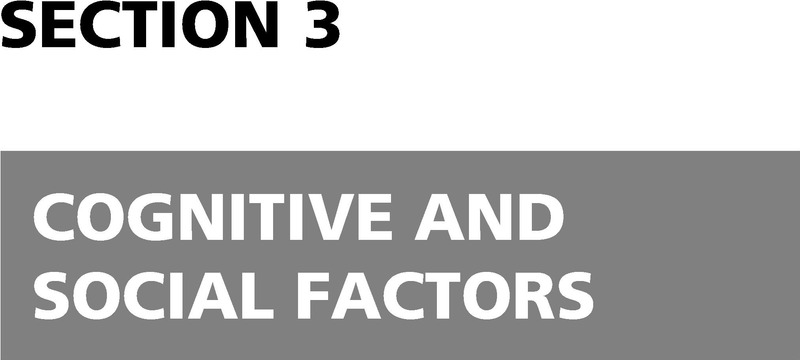Published online by Cambridge University Press: 20 July 2020

To give readers a broad coverage of the field we suggest reading articles written from various perspectives. We hope that the contradictions in these readings will encourage readers to think critically about this controversial topic.
Diane F. Halpern is Professor of Psychology Emerita from Claremont McKenna College and Dean of Social Sciences Emerita from Minerva Schools at KGI. She has published many books and hundreds of journal articles on sex differences in cognitive abilities and critical thinking, and is the author of the Halpern Critical Thinking Assessment (HCTA). She is past president of the American Psychological Association, the Western Psychological Association, and the Society for the Teaching of Psychology. She was named the Federation of Associations in Behavioral & Brain Sciences (FABBS) Honored Scientist (IHO) “Who made important and lasting contributions to the science of mind, brain, and behavior.” www.fabbs.org/fabbs-foundation/honoring-our-scientists/honor-diane-f-ha/
Halpern was born in Philadelphia, Pennsylvania. In order to get a better understanding of psychology from numerous cultures, she taught courses (most of them a semester long) in Canada, Mexico, Turkey, Russia, China, and Portugal, among other places. Her parents immigrated to the United States to escape the dangerous growth of anti-Semitism in Europe. Her father was from Romania and her mother was from Poland. Her first language was Yiddish, which developed as a fusion of German, Hebrew, Aramaic, and Slavic languages. She has a racially mixed family.
Carmen Flores-Mendoza is a psychologist at Federal University of Minas Gerais, Brazil. She works on individual differences in intelligence and personality, especially in the Latin American context. Flores-Mendoza was born in Lima, Peru. In the 1980s, her family moved to Brazil to escape the armed conflict (internal war) between the government of Peru and the Communist Party of Peru (a terrorist group known as Shining Path). The armed conflict turned Peru into a country where it was not safe to live. Now she has two nationalities: Peruvian and Brazilian. She attended University in the state of São Paulo, Brazil, and received her PhD from University of São Paulo. Her paternal grandmother was Chinese, and her paternal grandfather was indigenous Peruvian. Her maternal grandmother was “mulatto” (Black + White), and her maternal grandfather was a Spaniard (from Spain). So, Flores-Mendoza represents a mix of races.
Heiner Rindermann is a psychologist at TU Chemnitz, Germany, and works on education, ability development, intelligence, student achievement, economy and culture, and their interplay at the level of individuals and societies. Rindermann was born in Cologne, Germany, and grew up in Baden-Württemberg. He received his PhD from Heidelberg University. From 2008 to 2010, he was Professor of Evaluation and Methodology of Developmental Psychology at the University of Graz in Austria. He is a member of ISIR, APS, AEA, and Heterodox Academy. Science is for him an intellectual-philosophical task. He likes to walk, camp, and swim in the wilderness. He also likes to take photos (nature, architecture, art, people).
Joyce S. Pang is currently an Associate Professor of Psychology at Nanyang Technological University, Singapore. As a personality psychologist, she is interested in the assessment of individual differences and in making finer distinctions between personality dimensions in order to increase theoretical understanding of how personality affects behavior. Specifically, she adopts a person x situation perspective to understand how individual differences in motivation predict different reactions within different social contexts, which in turn lead to important personal and social outcomes. She is particularly interested in the implicit motives for achievement, power, and affiliation: how to measure them, make differentiations between them, and determine how individual differences in these motives affect performance, health, and well-being. Pang was born and raised in Singapore. She attended Smith College in Massachusetts for her BA and obtained her PhD from University of Michigan. She picked up Argentine tango in graduate school, and has danced ever since. After she obtained tenure, she took a short leave of absence to spend a couple months in Argentina learning more about the dance. She is currently living and working in Switzerland, and expects to be there for another two years.
Nicola Baumann is a Full Professor at the University of Trier, Germany. She did her diploma, PhD, and habilitation (the German postdoc qualification to gain tenure) at the University of Osnabrück. She has held research fellowships at the University of Rochester, New York (1999–2000), the Victoria University of Wellington, New Zealand (2014–2015), and the University of Colorado at Boulder (2019). Baumann’s research on implicit motives, self-regulation, and self-determination is located at the intersection of personality, motivation, cognition, and social psychology. She investigates the “what” (what moves people to action) and “how” (how people regulate their action) of human goal striving from the broader perspective of Personality Systems Interactions (PSI) theory. In addition to her scientific achievements, she has worked as an applied psychologist and nurtures the exchange between research and practice.
Baumann was born and raised in Germany. She had four one-year stays abroad: 1983–1984 University High School of Northern Colorado, USA (at age 16); 1999–2000 University of Rochester, New York; 2014–2015 Victoria University of Wellington, New Zealand; and 2019 University of Colorado at Boulder, Colorado. At the University of Osnabrück, there was a good mix of colleagues from the USA and Russia, allowing the integration of very different approaches to science.
Sumaya Laher is an Associate Professor in Psychology at the University of the Witwatersrand. Her doctoral and subsequent research into personality, psychometrics, and assessment has been instrumental in pioneering the usage and interpretation of key instruments in South Africa. Aside from psychological assessment, she contributes actively to research on indigenous knowledge systems with her work on traditional healing systems particularly those proposed by Islam, Hinduism, and African approaches. Laher is a South African Muslim woman born in Johannesburg, and completed her undergraduate and doctoral studies at the University of the Witwatersrand in Johannesburg.
Fanny M. Cheung is Choh-ming Li Professor of Psychology and Vice-President (Research) at the Chinese University of Hong Kong. Her research expertise lies in cross-cultural personality assessment. She pioneered gender research in Greater China and served as the Founding Chairperson of the Equal Opportunities Commission in Hong Kong. She received the 2014 IAAP Distinguished Scientific Contribution Award and 2012 APA Award for Distinguished Contributions to the International Advancement of Psychology for her contributions to personality assessment across cultures and to the international advancement of women. Cheung was born in Hong Kong and studied in the United States for nine years from Grade 12 through her PhD degree. She returned to work in Hong Kong after her studies, and has spent sabbaticals in Oxford (UK) and the United States.
Pia Zeinoun is an Assistant Professor of Psychology at the American University of Beirut’s Department of Psychology, and is Managing Director of the Psychological Assessment Center at the AUB Medical Center. Her research centers on the development of culturally appropriate tests of personality, psychopathology, and neurocognitive abilities. Dr. Zeinoun has a PhD in Psychology from Tilburg University in the Netherlands, and advanced graduate training at the Johns Hopkins/Kennedy Krieger Institute in Maryland, USA. Zeinoun was born in Lebanon, but sought refuge in Cyprus with her family during the Lebanese Civil War. After spending ten years in Cyprus, where Greek became her native language, she returned to Lebanon as a teenager. It was only then that she learned English at an American-system school, and Arabic as a second language. She has now settled in her diverse country of origin, Lebanon.
Algae K. Y. Au was born and raised in Hong Kong. She is currently a PhD candidate in the Department of Applied Social Sciences at the Hong Kong Polytechnic University. During her undergraduate studies, she was a first-class honors student, a two-time winner of the Scholarship for Outstanding Students, and a recipient of the Outstanding Thesis Award in Psychology, and she was included on the Dean’s Honors List. Her research interests include bilingualism, biculturalism, and intercultural relationships, which have also been the major areas of her publications in the past few years. Guided by her current interest in ecopsychology, her doctoral thesis focuses on the effects of ecological self-construal on psychological and pro-environmental outcomes.
Sylvia Xiaohua Chen is a Professor in the Department of Applied Social Sciences at the Hong Kong Polytechnic University. Her research interests include the social psychology of bilingualism and biculturalism, personality and social behavior in cultural contexts, cultural diversity and mental health, and, more recently, globalization and multiculturalism. She served as an Associate Editor of Journal of Cross-Cultural Psychology and Asian Journal of Social Psychology. She was a recipient of an Early Career Award conferred by the International Association for Cross-Cultural Psychology, Michael Harris Bond Award for Early Career Research Contributions, and Jung-heun Park Young Scholar Award conferred by the Asian Association of Social Psychology. Chen was born in Guangzhou, China and grew up there. She attended college at Sun Yat-Sen University in Guangzhou, and obtained her MA at Santa Clara University in the USA, where she studied and worked for six years. Then she studied for an MPhil and PhD at the Chinese University of Hong Kong. She has remained in Hong Kong for over 20 years. As a social and cultural psychologist, she believes she is influenced by Hong Kong, Mainland Chinese, and American cultures.
Susan E. Cross is a faculty member of the Department of Psychology at Iowa State University. Her current research focuses on the intersection of culture, self, and close relationships. Specifically, she studies how concerns for honor motivate behavior in cultures such as Turkey and southern regions of the USA (funded by the US National Science Foundation). She is also curious about how cultural values, norms, and beliefs influence conceptions of close relationships in East Asian contexts. Her background is eclectic, with degrees in Horticulture and Higher Education, but she found her way to a PhD program at the University of Michigan, where she had the privilege of working with Professor Hazel Markus. She is thankful every day for the opportunity to pursue interesting questions with students and postdoctoral scholars from around the world. Cross was born and raised in Texas, by two natives of the US South. She considers herself a product of an honor culture. When she was a senior in college, her father moved first to Saudi Arabia (for three years) and then to Tokyo (for three years). Visiting these countries sparked her interest in culture, in part because, although both countries were collectivist, non-Western contexts, they differed greatly from each other. Cross is a motherless woman, who has valued the presence of women friends, aunts, and others who filled in the gap for her. She identifies as a Christian; a White woman married to a Hispanic man; a Texan/ Southerner; a mother of boys; a gardener; and many other things.
Elysia G. Sotiriou is in her final year of the Counseling Psychology doctoral program in the Department of Educational Psychology at the University of Texas at Austin. Her research involves exploring the impact of culture on body image development and eating disorder risk, designing culturally inclusive measures to capture the body-related concerns of ethnic minority women, and expanding efficacious body image interventions to benefit under-served populations. Throughout her academic and clinical practicum opportunities, Elysia has cultivated a multitude of unique experiences working clinically with culturally diverse children, adolescents, and young adult women struggling with a range of body-related concerns. Elysia is currently a fellowship scholar in the Austin & Dell Medical School’s Integrated Behavioral Health (UT) program, a comprehensive, multidisciplinary training initiative designed to prepare culturally and linguistically diverse trainees to pursue careers treating under-served populations in integrated healthcare settings. Sotiriou was born and raised in Salt Lake City, Utah. She received her BA in psychology, sociology, and French from University of Wisconsin, Madison. Her graduate degrees are from the University of Texas, Austin. Upon graduating from UW-Madison, she accepted a job in Greece and moved to Athens just before the second austerity bill and the first wave of violent protests began. She studied in Paris, at La Sorbonne, for a year in 2010.
Germine H. Awad is an Associate Professor in the Human Development, Culture, and Learning Sciences and Counseling Psychology programs in the Department of Educational Psychology at the University of Texas at Austin. Her scholarship is characterized by three interrelated areas of inquiry: prejudice and discrimination, identity and acculturation, and body image among women of color. She has also written in the area of multicultural research methodology. The majority of her research is guided by the questions “What factors lead to discrimination against ethnic minorities?” and “What impacts perceptions of experienced discrimination?” The two populations that she has primarily focused on are Arab/Middle Eastern Americans and African Americans. Awad is concerned with how prejudicial attitudes and ideology impact attitudes toward ethnic minorities generally and within specific domains such as the workplace and higher education. In addition, she examines how racial/ethnic identity and acculturation impact ethnic minorities’ perception of discrimination, their experience of their bodies, and development of body image concerns.
Theresa K. Vescio is a Professor of Psychology and Women’s, Gender, and Sexuality Studies at the Pennsylvania State University. Her research seeks to understand the factors that facilitate and temper the expression of sexism, racism, and heterosexism. Vescio is particularly interested in the interplay between the stereotypic behaviors of powerful people and the consequences that those behaviors have for the emotions, motivation, and performance of low-power women, gay men, and people of color. Vescio was born in Minneapolis, as the child of teenage parents. She spent her youth running around the neighborhood, caring for younger siblings, in lakes, and playing sports. She worked with her grandmother and cousins in a family owned restaurant to support her undergraduate studies at the University of Minnesota. She started graduate school at the University of Florida, where she got her master?s degree. She then moved with her advisor to the University of Kansas, where she got her PhD. She did her postdoctoral work at the University of Cardiff, in Wales, and at Berkeley, before accepting a job at Penn State. She is a lesbian feminist scholar, activist, and parent.
Natasza Kosakowska-Berezecka works as an Associate Professor in the Division of Cross-Cultural Psychology and Psychology of Gender at the University of Gdańsk (Poland). Her main area of research is the cultural cues fostering gender equality within societies across the world. She also conducts research on the backlash against communal men and against the universality of precarious manhood. She is Principal Investigator within Towards Gender Harmony project (www.towardsgenderharmony.ug.edu.pl) where collaborators in over 50 countries are collecting data concerning the concepts of contemporary femininity and masculinity. She also applies her academic expertise to practitioners? work as she is a diversity and inclusion trainer ? she realized her applied projects in Norway or India. Kosakowska-Berezecka was born and raised in Gdynia, Poland, by the Baltic Sea. She lived for a long time in Norway. She is a feminist and a social activist.
Rachel Karniol is Professor of Social Development in the School of Psychological Sciences at Tel Aviv University. She was born in Israel to Holocaust survivors from Hungary and Transylvania. Hungarian was her first language, Hebrew was her second language, and English became her third language after arriving in Canada in 6th grade. After completing her PhD at the University of Waterloo, Canada, she taught at the University of Toronto. During sabbaticals she also taught at Princeton University, Carnegie Mellon University, Tufts University, and University of Florida. Her expertise is at the crossroads of social and developmental psychology, with a focus on the process of understanding other people, empathy, moral development, and gender. Her research has appeared in Psychological Review, Psychological Bulletin, Annual Review of Psychology, Developmental Review, and Journal of Personality and Social Psychology. Her book Social development as preference management: How infants, children, and parents get what they want from each other was published by Cambridge University Press (2010). Karniol’s husband, who was a Professor of Aerospace Engineering at the Technion in Haifa, Israel, is also the child of Holocaust survivors and was born in Poland. They raised their two children as Hebrew–English bilingual.
Sabina Čehajić-Clancy is an Associate Professor of Social and Political Psychology at the Sarajevo School of Science and Technology. She holds a PhD in Social Psychology from Sussex University and is affiliated with Stanford University as a former Fulbright Scholar. Čehajić-Clancy is an expert in the area of intergroup reconciliation, for which she has received many dissertation and career awards. Her research integrates theories on intergroup relations, emotion regulation, and moral disengagement, combining the experimental lab studies with field experiments. She has published articles in Psychological Inquiry, Journal of Personality and Social Psychology, Group Processes & Intergroup Relations, and Political Psychology, two books, and numerous contributions to edited volumes or encyclopedias. She also serves on editorial boards for Political Psychology and the European Journal of Social Psychology. Her research has been funded by prestigious research councils, among them the Economic and Social Research Council and the British Academy. In addition to her research excellence, she has over fifteen years of experience in working as a consultant for USAID, UN agencies, and other more grassroots-based NGOs in the area of education, peace building, and reconciliation. Her work has also received wide national and international coverage. Website: cehajicsabina.wixsite.com/clancy
Sharon Ng is Associate Professor of Marketing at Nanyang Business School, Singapore. She is currently the Head of Division for Marketing and International Business. Ng received her PhD from the University of Minnesota. She has published in the top marketing journals, such as Journal of Marketing Research, Journal of Consumer Research, and Journal of Consumer Psychology. She was named a MSI Young Scholar by the Marketing Science Institute (USA) in 2009, which selects 30 scholars globally whose work suggests they are potential leaders of the next generation of marketing academics. Ng is the Area Editor of the International Journal of Research in Marketing and sits on the editorial board of Journal of Business Research and Australasian Marketing Journal. She is also the co-editor of the Handbook of culture and consumer behavior published by Oxford University Press in 2015. Growing up in Singapore, she has been always been fascinated by how culture influences people’s behavior. Singapore’s multiculturalism provided an early introduction to the importance of being sensitive to cultural differences and this also shapes her research interest.
Mehak Bharti is a PhD student in Marketing at Nanyang Technological University, Singapore. Prior to this, she did her MBA and spent four years working in the areas of digital strategy and research. Her research interests lie in understanding online consumer behavior, consumer mindsets, cultural background, and gender. Though originally from India, her experiences of living in different countries like India, France, and Singapore have shaped her understanding of the influence of culture in various aspects of our everyday life and behavior.
Natalie Truong Faust is an Assistant Professor of Marketing at NOVA School of Business and Economics, Portugal. She received her PhD in Marketing from the Norwegian School of Economics and was a postdoctoral research fellow at Nanyang Technological University, Singapore. Her work focuses on consumer behavior, in which her main topics of investigation include beauty/aesthetics, gender, and implicit theories. Originally from Vietnam, Natalie’s experience of living in different cultures has provided much insight into how cultural factors contribute to shaping gendered meaning across various consumption contexts.
Adam Davis is currently enrolled in a PhD program in Education at the University of Ottawa. His principal research interests involve using an evolutionary perspective, particularly sexual selection theory, to study dark personality traits, jealousy, and aggressive behavior among adolescents and young adults. His secondary program of research is focused around studying the links between cognitive styles, environmental values, and pro-environmental behavior. Davis was born in Ontario, Canada where he has lived his entire life. He has spent two weeks in Honduras during graduate school helping graduate students with behavioral ecology research on howler monkeys. He identifies himself as atheist, democratic socialist, and feminist.
Tracy Vaillancourt is a Tier 1 Canada Research Chair in School-Based Mental Health and Violence Prevention at the University of Ottawa where she is cross-appointed as a Full Professor in Counselling Psychology and the School of Psychology. She is also an elected member of the College of the Royal Society of Canada. She received her BA, MA, and PhD from the University of British Columbia (human development), her postdoctoral diploma from the University of Montreal and Laval University (developmental psychology), and postdoctoral respecialization in applied child psychology (clinical) from McGill University. Vaillancourt’s research examines the links between bullying and mental health, with a particular focus on social neuroscience. She is currently funded by the Canadian Institutes of Health Research and the Social Sciences and Humanities Council of Canada.
John Archer is an Emeritus Professor at the University of Central Lancashire, Preston. He has been an active researcher in the field of aggressive behavior for more than 40 years, focusing his research on aggression and violence and, in particular, sex differences in aggression, including in relation to sexual selection, partner violence, the relations between testosterone and aggression, and resource holding power and aggression. Archer served as the editor-in-chief of Aggressive Behavior from 2012 to 2018. He was recipient of the John Paul Scott Award from the International Society for Research on Aggression (ISRA) in 2016, and was made a Life Fellow of ISRA in 2018 “in recognition of his distinguished lifetime contribution to research on aggression.” Born in Windsor, UK, he went to University College of Wales, Aberystwyth, for his undergraduate degree and University of Bristol for his PhD.
To save this book to your Kindle, first ensure [email protected] is added to your Approved Personal Document E-mail List under your Personal Document Settings on the Manage Your Content and Devices page of your Amazon account. Then enter the ‘name’ part of your Kindle email address below. Find out more about saving to your Kindle.
Note you can select to save to either the @free.kindle.com or @kindle.com variations. ‘@free.kindle.com’ emails are free but can only be saved to your device when it is connected to wi-fi. ‘@kindle.com’ emails can be delivered even when you are not connected to wi-fi, but note that service fees apply.
Find out more about the Kindle Personal Document Service.
To save content items to your account, please confirm that you agree to abide by our usage policies. If this is the first time you use this feature, you will be asked to authorise Cambridge Core to connect with your account. Find out more about saving content to Dropbox.
To save content items to your account, please confirm that you agree to abide by our usage policies. If this is the first time you use this feature, you will be asked to authorise Cambridge Core to connect with your account. Find out more about saving content to Google Drive.






















